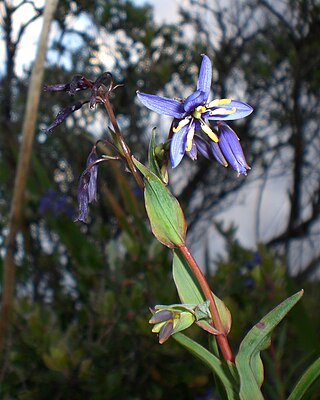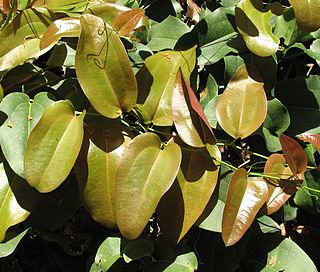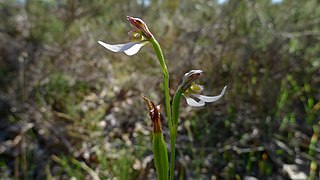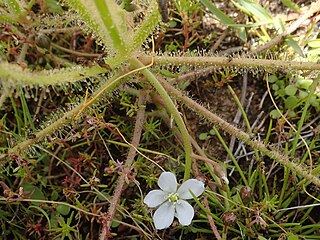
Royal Botanic Gardens, Kew is a non-departmental public body in the United Kingdom sponsored by the Department for Environment, Food and Rural Affairs. An internationally important botanical research and education institution, it employs 1,100 staff. Its board of trustees is chaired by Dame Amelia Fawcett.

Macrozamia is a genus of around forty cycad species endemic to Australia. Many parts of the plant have been utilised for food and material, most of which is toxic if not processed correctly.

Drakaea is a genus of 10 species in the plant family Orchidaceae commonly known as hammer orchids. All ten species occur only in the south-west of Western Australia. Hammer orchids are characterised by an insectoid labellum that is attached to a narrow, hinged stem, which holds it aloft. The stem can hinge only backwards, where the broadly winged column carries the pollen and stigma. Each species of hammer orchid is pollinated by a specific species of thynnid wasp. Thynnid wasps are unusual in that the female is flightless and mating occurs when the male carries a female away to a source of food. The labellum of the orchid resembles a female thynnid wasp in shape, colour and scent. Insect pollination involving sexual attraction is common in orchids but the interaction between the male thynnid wasp and the hammer orchid is unique in that it involves the insect trying to fly away with a part of the flower.

Cyrtostylis, commonly known as gnat orchids, is a genus of five or six species of flowering plants in the orchid family Orchidaceae and is native to Australia and New Zealand. Cyrtostylis orchids often form dense colonies of genetically identical plants. They have a single heart-shaped leaf and a thin flowering stem with pale coloured insect-like flowers. The lateral sepals and petals are similar in size and colour but the labellum is shelf-like and conspicuous with two prominent glands at its base.

Sowerbaea is a small genus of perennial herbs which are endemic to Australia.

Stypandra is a small genus of rhizomatous perennials in the family Asphodelaceae, subfamily Hemerocallidoideae. They are native to Australia and New Caledonia.

Dipodium, commonly known as hyacinth orchids, is a genus of about forty species of orchids native to tropical, subtropical and temperate regions of south-east Asia, New Guinea, the Pacific Islands and Australia. It includes both terrestrial and climbing species, some with leaves and some leafless, but all with large, often colourful flowers on tall flowering stems. It is the only genus of its alliance, Dipodium.

Spinifex longifolius, commonly known as beach spinifex, is a perennial grass that grows in sandy regions along the seacoast. It also lives in most deserts around Australia.

Melaleuca lanceolata commonly known as black paperbark, moonah, Rottnest Island teatree and western black tea tree is a plant in the myrtle family, Myrtaceae and is native to Australia where it occurs in Western Australia, South Australia, Victoria, New South Wales and Queensland. It is a densely foliaged tree with rough bark, which flowers prolifically in summer.

Halophila is a genus of seagrasses in the family Hydrocharitaceae, the tape-grasses. It was described as a genus in 1806. The number of its contained species, and its own placement in the order Alismatales, has evolved.

Smilax australis is a vine in the family Smilacaceae, endemic to Australia. It has prickly climbing stems that are up to 8 metres long with coiled tendrils that are up to 20 cm long. The glossy leaves have 5 prominent longitudinal veins and are 5 to 15 cm long and 3 to 10 cm wide.

Dichopogon is a genus of perennial herbs, native to Australia and New Guinea. It is included in the genus Arthropodium by some authorities, although recognized as a distinct genus by others. In the APG III classification system, it is placed in the family Asparagaceae, subfamily Lomandroideae.

Eriochilus, commonly known as bunny orchids, is a genus of flowering plants in the orchid family, Orchidaceae that is endemic to Australia. Orchids in this genus are distinguished from those in the similar Caladenia by having a glabrous leaf and a densely woolly labellum. Species occur in south-west Western Australia, South Australia, Queensland, New South Wales, the Australian Capital Territory, Victoria, and Tasmania. Their common name alludes to their prominent ear-like lateral sepals.

Mesomelaena is a genus of sedges. It has 5 known species, all endemic to Western Australia.

Laxmannia is a genus of tufted perennial herbs in the family Asparagaceae, subfamily Lomandroideae, that are endemic to Australia.
Zeuxine oblonga , commonly known as the common jewel orchid is a species of orchid that is endemic to northern Australia. It has up to seven narrow egg-shaped leaves and up to thirty small green and white flowers crowded along a fleshy, hairy flowering stem. It mainly grows in wet forest and rainforest.

Chloanthes is a genus of four species of flowering plants in the family Lamiaceae and is endemic to Australia. Plants in this genus are shrubs with hairy foliage, blistered or wrinkly leaves and flowers with five petals fused at the base, usually with two "lips".

Melaleuca glauca, commonly known as Albany bottlebrush is a plant in the myrtle family, Myrtaceae and is endemic to the south-west of Western Australia. It is a tall shrub with glaucous leaves and spikes of red flowers in spring.
Cyperus pulchellus is a sedge of the family Cyperaceae that is native to northern Australia, tropical Africa, northwest Madagascar and Southeast Asia.

Drosera finlaysoniana is a species of sundew native to Australia, Hainan, Taiwan, the Philippines and Mainland Southeast Asia. Like other members of Drosera sect. Arachnopus it is an annual.



















